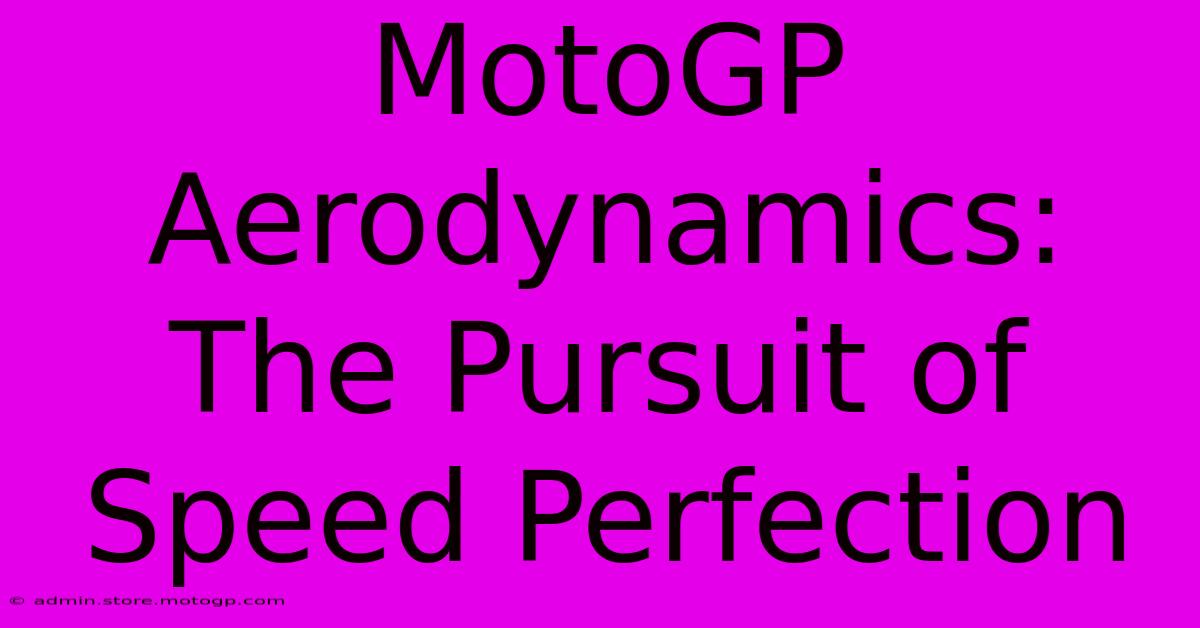MotoGP Aerodynamics: The Pursuit Of Speed Perfection

Table of Contents
MotoGP Aerodynamics: The Pursuit of Speed Perfection
MotoGP racing isn't just about powerful engines and skilled riders; it's a relentless pursuit of aerodynamic perfection. Every millisecond shaved off lap times often comes down to the intricate design and performance of the bikes' aerodynamic components. This article delves into the crucial role of aerodynamics in MotoGP, exploring the complex science behind the wings, winglets, and fairings that define these cutting-edge machines.
Understanding the Aerodynamic Challenges
MotoGP bikes, traveling at speeds exceeding 200 mph (320 km/h), face immense aerodynamic forces. These forces, including drag and lift, significantly impact performance. Drag resists the bike's forward motion, slowing it down, while lift can cause the front wheel to lose contact with the track, leading to instability and crashes. The challenge for engineers is to minimize drag while managing lift effectively.
The Impact of Speed and Downforce
At high speeds, aerodynamic forces become exponentially larger. Generating sufficient downforce – the aerodynamic force pushing the bike towards the track – is vital for stability and cornering speed. Downforce allows riders to brake later, accelerate earlier, and lean further into corners without losing control, ultimately leading to faster lap times. However, excessive downforce can increase drag, negating the benefits. The key lies in finding the optimal balance.
Key Aerodynamic Components and Their Function
Several key components play crucial roles in managing MotoGP bike aerodynamics:
1. Fairings:
The fairing, the bodywork surrounding the engine and other components, is meticulously designed to streamline airflow and minimize drag. Its shape dictates how air flows around the bike, influencing both drag and downforce. Even small changes to the fairing's design can result in noticeable performance gains.
2. Wings and Winglets:
These are the most visually striking aerodynamic aids. Wings, typically located at the front and rear of the bike, generate downforce by deflecting air downwards. Winglets, smaller wing-like structures, are strategically positioned to fine-tune airflow and enhance downforce in specific areas. Their placement and angle are critical for maximizing performance. The development of these components is a constant arms race, with teams always searching for marginal improvements.
3. Aerodynamic Appendices:
Beyond wings and winglets, teams employ smaller, less obvious aerodynamic devices called appendices. These subtle elements—sometimes resembling small fins or spoilers—are used to manage airflow around specific areas of the bike, further optimizing downforce and drag.
The Constant Evolution of MotoGP Aerodynamics
MotoGP aerodynamics are in a state of constant evolution. Teams employ sophisticated computational fluid dynamics (CFD) simulations and wind tunnel testing to refine designs. They continuously experiment with new shapes, materials, and configurations to find the optimal aerodynamic balance. The rules governing aerodynamic devices frequently change, forcing teams to innovate and adapt. This constant push for improvement is a key factor in the relentless speed increase we see in MotoGP racing.
The Rider's Role in Aerodynamic Performance
While engineers design the aerodynamic components, the rider plays a significant role in maximizing their effectiveness. The rider's body position and riding style can influence airflow around the bike, affecting both drag and downforce. Optimizing the rider's position and technique is crucial for harnessing the full potential of the bike's aerodynamic features.
Conclusion: A Continuous Quest for Perfection
Aerodynamics represent a critical element in the quest for speed perfection in MotoGP. The intricate interplay between design, technology, and rider skill is what makes MotoGP such a captivating and technologically advanced sport. The continuous development and refinement of aerodynamic components will undoubtedly continue to push the boundaries of speed and performance in future seasons. The pursuit of aerodynamic perfection is an ongoing journey, promising further advancements and exhilarating racing in the years to come.

Thank you for visiting our website wich cover about MotoGP Aerodynamics: The Pursuit Of Speed Perfection. We hope the information provided has been useful to you. Feel free to contact us if you have any questions or need further assistance. See you next time and dont miss to bookmark.
Featured Posts
-
Choosing Your First Moto 3 Bike Expert Advice
Feb 20, 2025
-
Cota Parking The Easiest Way To Park At Cota
Feb 20, 2025
-
Cota General Admission A True Fans Experience
Feb 20, 2025
-
The History And Evolution Of Motorbike Racing
Feb 20, 2025
-
Cota Parking Parking Pass Purchase Information
Feb 20, 2025
